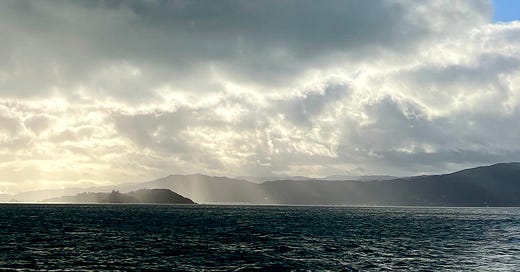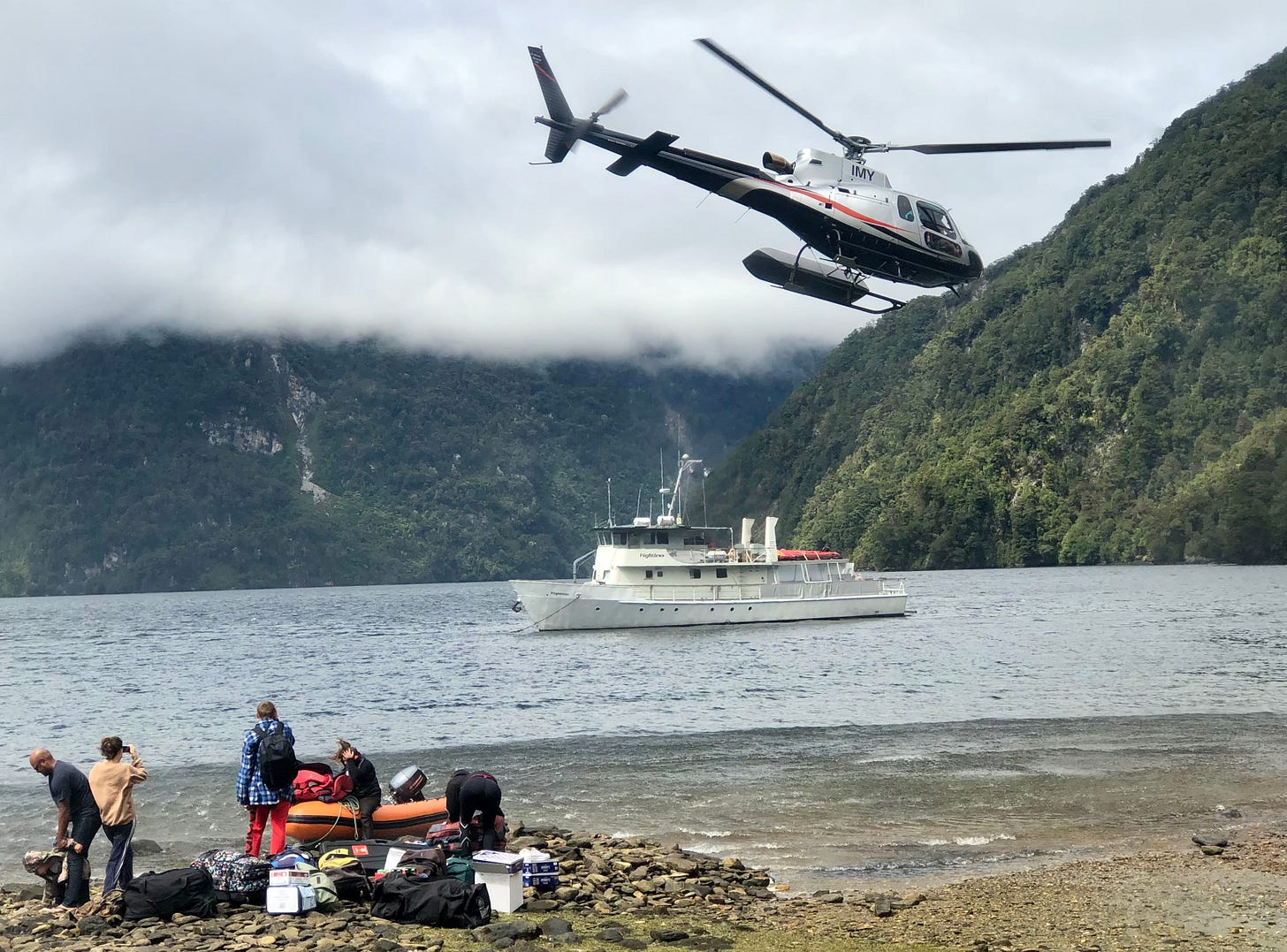A Cook Strait ferry solution🍋
Modern ferry loading technologies & separate ownership trump the 1962 model
The problem
The Government has announced that it (i.e. taxpayers) will not stump up $3bn for new Interislander ferries and terminals. The government-owned operator, KiwiRail, could not afford to pay for them itself. At present KiwiRail has three ageing vessels, ageing terminals, and no plan for the longer term. Private sector rival Bluebridge continues to operate two Cook Strait ferries, and periodically replace them, without government help.
Cook Strait ferries have provided a valuable link in New Zealand’s transport chain since 1875. From 1962, KiwiRail (and its predecessors1) have operated roll-on roll-off (RoRo — that is, the freight drives itself on and off the ferry) road/rail/passenger ferries2, usually profitably. Privately owned Bluebridge joined in with road/passenger ferries in 2002. What has now gone wrong?
The problem goes back to previous Ministers and previous (now departed) KiwiRail management, who not only decided on two large new ferries but also that these had to be capable of carrying trains. One can infer that this was not only a ferry decision but also reflected a view about protecting the railway main trunk.
You don’t need a rail ferry to move rail freight. Containers could arrive at Wellington or Picton by train and be efficiently moved onto the ship using new transfer technologies (see below). The alternative would have been normal RoRo road ferries (without rail tracks) combined with these new technologies.
The best option in 1962 is not the best now. In those days rail freight was relatively important, while roads and trucks were relatively primitive. Now road freight predominates on most routes, except a few that are far from Cook Strait: Tauranga-Hamilton-Auckland and Canterbury-West Coast.
Modern ferry loading technologies
Technologies to efficiently shift freight between modes (between trains, ships trucks and planes) are now used in various forms in Scandinavia, the south of Italy, elsewhere in the Mediterranean, Tasmania, and Switzerland. For an example, see this one-minute video of the Köseköy logistics terminal, showing trains “converting” to trucks to make the most of both transport modes.
Other technologies include:
cassettes (hydraulically lifted bogies);
terminal trailers/dollies (with heavy, solid tires, able to take heavy loads including double stacking, which makes better use of space on the ship); and
different forms of top loader and straddle carriers.
Although it is simple to shunt trains straight onto a ship, low operational costs are offset by:
increased capital costs (i.e. the problem the government is experiencing now);
less efficient use of space in the terminals and on the ship (see below);
decreased resilience. A basic RoRo connection is less vulnerable to earthquakes and accidents than is a complex rail link3 (the Interislander terminal at Kaiwharawhara is on a fault line); and
higher port ownership costs and risks because rail ferries do not have the benefit of being in an international market of similar ships (see below).
Terminals
Rail ferries are more expensive than conventional roll-on roll-off (RoRo) ferries. Another cost comes at the ports, where the requirement to accommodate rail introduces challenges in space and infrastructure.
The existing terminals date from 1962 when the rail ferries were first introduced. Those ships were 110m length and 18m wide (the new ones will be 230m long). Like grandad’s axe, the infrastructure has been re-purposed over and over, with most of it poorly configured for current operations and at the end of its economic life.
Modern well-configured terminals are key to making the most of the new ships. All of the critical activity of exchanging rail, trucks, cars and people (as well as provisioning, fueling, water, servicing, garbage) happens in a very short space of time when the ship is in the port. For this the infrastructure and supporting systems must be optimised. Examples in Europe show how this can be done well — at Dover an average 6,000 trucks pass through each day, and each ship spends only around 40 minutes in the port each time.
New terminals are needed in any case, but there are additional costs when they are rail-enabled (in the past, estimated to be 20-25% higher, now much more):
Rail ferries need bespoke linkspans so the railway wagons can be pushed onto the ship.
These bespoke linkspans are large, expensive and vulnerable. They pose a risk especially in a seismically difficult area such as Kaiwharawhara. In contrast, RoRo ferries use cheaper more generic linkspans meaning that facilities can be shared, and the risk of failure of single pieces of infrastructure is reduced.
Larger and longer linkspans mean longer wharves are needed.
Accommodating rail shunting yards at terminals needs land to be reserved for rail-only operations and expensive overbridging of roads. Likewise, rail lines inside ships leave empty corners.
Use of normal RoRo (non-rail) ferries would allow a rationalisation of land use between KiwiRail and the port companies, potentially freeing up land for other activities and allowing more efficient operations by both ferry companies.
A normal RoRo model is more conducive to sharing terminal facilities, passenger spaces, linkspans, wharves and marshalling, and therefore use prime waterfront land more efficiently. Interislander ferries could be accommodated, together with ferries from the rival company Bluebridge, in an airport-type port facility – that is, a ferry terminal accommodating both companies just as airports cater to multiple airlines. This would have economies of scale and better operational flexibility. In a rail-ferry model, the requirement for bespoke and conflicting infrastructure makes this far harder.4
On the ships, the use of vehicle deck space on rail ferries is less efficient, with empty spaces left on the rail deck and that can’t easily or safely be used by trucks and cars.
Investment management
There is an established market for normal RoRo ferries – there are many of them in the Mediterranean and elsewhere. It is relatively easy to obtain additional RoRo ferries or dispose of surplus ones. It is also easier to grow the fleet incrementally, adding one at a time – an advantage, as Bluebridge shows, in managing the risks associated with investing in a fleet.
However rail ferries would be orphan assets. They would have to be purchased new, and there is no ready market for them because of their specific design, including New Zealand’s narrow rail gauge (the distance between the rails, 1067mm instead of the standard 1435mm).
Ownership
It is not clear why a railway operator wants to be involved in owning and operating port facilities. Its business is trains (plus or minus ferries), not running ports. The port’s workforce is capable of this work, so why duplicate with your own staff? Why own marine infrastructure and maintain it yourself, when the port already has those facilities and skills? Why not share facilities and staffing as much as practical and focus on your core business?
Ferry ownership by the Railways Department reflects 1960s history, when the previous legacy ferry operator, the Union Steamship Company, proved incapable of innovating to adopt to the new RoRo technology. The government got involved, and the Railways Department became the operator.
There is also no need for KiwiRail to own a ferry-operating company. KiwiRail just needs to be served by two or more ferry companies, which it doesn’t need to own itself. KiwiRail could sell its interest in Interislander and make a capital gain (despite the new ferry debacle, the business is fundamentally profitable)5. The new owner would be like Bluebridge and compete with it. (The Commerce Act could be used to ensure there were two operators rather than a monopoly.)
The solution
My proposed solution to the excessive costs of new ferries and terminals is:
To negotiate a new contract for a standard non-rail RoRo ferry, to replace the most worn out of the current Interislander fleet. There will be a loss from breaking the present contract but a gain from buying something simpler.
Or, alternatively, buy a used RoRo ferry.
Later, another ferry could replace the next oldest in the Interislander fleet.
Simplify terminal plans to suit non-rail RoRo ferries. The resulting new terminals will be cheaper, more resilient, and more efficient to operate than combined rail/road terminals.
Seek a private buyer for the Interislander business, to compete with Bluebridge. The capital from the sale would help finance the overall package.
By David Greig
Since 1962, the Interislander ferry service has been owned and operated by a series of government departments, government-owned corporations, state-owned enterprises, and private and public companies. These include the Railways Department, New Zealand Railways Corporation, New Zealand Rail Limited, Tranz Rail, Toll NZ and KiwiRail.
Vehicles drive on (“roll on”) and off (“roll off”) the ferries via a linkspan. With older ferries (before 1962 in NZ) vehicles were lifted from wharves on and off the vessel.
It is also easy to construct cheap emergency backup RoRo connections elsewhere, being essentially a concrete ramp (on which a simple linkspan can be lowered) and bollards (vertical posts) to moor the ship.
Unless both ferry companies convert to rail, which as far as I know is not on the cards for Bluebridge.
Bluebridge (or more specifically, its corporate parent StraitNZ) sold for more than $500m in 2021. At the time it had a 56% market share in vehicle freight and a 31% share of the passenger market in Cook Strait. Freed of its rail freight constraints and ambitions, Interislander should attract a similar sale price.









It would be interesting to understand if the analysis has been done on having a ferry direct to Lyttleton? Isnt that where a large proportion of what's rolling on and off is going?
Interesting given your background that none of your comments are supported by data. Bland statements about road being more efficient may or may not be correct if the multitude of subsidies to the transport sector are included. RUC are likely to be way to low, but then ferry subsidies may be too high. I don’t know but I expect with your history you do.
Do you have data?